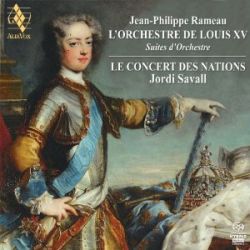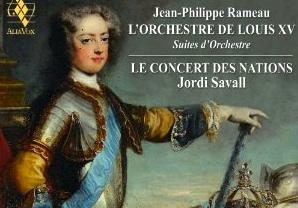
There are precious few infallible guarantors of musical fun, but “a good Baroque orchestra and a pile of Rameau” is one of them. I confess that when I first heard of this release — Jordi Savall and his Le Concert des Nations playing suites from four operas by Jean-Philippe Rameau — my first giddy enthusiasm was that a bunch of good Baroque players had recorded a boatload of Rameau, and only secondarily that it was Savall who was directing them.
The fact is that it’s possible for fine musicians to render even excellent music stultifyingly dull. Anyone who’s heard a number of front-rankers play enough Bach, Handel, Vivaldi, Haydn, Mozart, or Beethoven can attest to this. The dance music from Rameau’s operas, though, belongs to that tiny, charmed circle of great music that’s almost never played boringly.
Selection bias is at work here, of course: People who play Rameau are people who are (for starters) interested enough in the music to go to the trouble of finding parts for it, which often means making their own editions. Yet there are legions of musico-paleontological projects as diligently pursued by people as determined and as talented that wind up being received with a collective shrug. Something else is operating here.
Listen To The Music
Rameau: Les Indes Galantes - 1. OuvertureLes Boréades: Gavotte I & II pour le heures et les Zephirs
Purchase Recording

A portion of each purchase helps
support San Francisco Classical Voice
I think, at bottom, it’s a basic feature of the music: It has a surface so varied and fun that you simply can’t help but become involved with it. This is not music that plays itself — far from it. (Even the dances that are simple at first glance don’t come off without a certain level of casual virtuosity.) But it is music that, as it were, plays you. If you’re a musician, you find yourself gesturing even while listening to it; to play it is almost definitionally to dance.
That isn’t, unfortunately, quite the case with most 18th-century music. You need to “get” Haydn to play him well; you need to “get,” in the same way, nearly every 18th-century composer, because if the surface will do (as it will do for most any good composer), then an awful lot of people will stick with the surface. Rameau is simply different: If you’re playing him at all, you become so enamored with the surface that you get below it. And it’s not so much that other composers have less “surface”; it’s that the Rameau surface is so exceedingly cool that you can’t help but dip a further toe in.
So Savall has assembled here four not-quite-half-hour-long-each suites from four Rameau operas, ranging from Les Indes galantes of 1735 to Les Boréades of 1764, and it’s no disgrace to him or to his band to say that they play Rameau brilliantly — and so does everyone else who plays him at all.
If you want two hours or so of first-rate Rameau orchestral music, this is possibly the best place to start, and not merely because Savall’s set is the latest in a series of musical snapshots of the French royal line. (We have had Louis XIII through Louis XV now; Louis XVI ought to be interesting. ...) Savall isn’t afraid of brusque sounds, nor of gilding gold (I don’t think all the percussion in here was written out, for example). And his band, a “Concert des Nations” indeed to judge by the names in the roster (albeit one that slights England in favor of the Continent), plays its collective heart out for him.
This is, as I said, virtuosic music; you can’t make it work on guts alone. And indeed some of the finest playing here is in the most subdued numbers, like the pair of gavottes from Les Boréades, with their elfin flutes. But the gung-ho dash of Savall’s players becomes sheer delight in the weirder, brasher music. Strange syncopations and unheard-of dissonances and downright funky ritornellos are as raw meat to this band, and if it’s not always exactly pretty to hear them gobble it all up, it is infallibly interesting. Standard-issue cafe background Baroque this is not.
You’d think that the enthusiasm here would wear thin over the course of two hours, yet it doesn’t. This is the sort of playing, and the sort of music, where the prospect of more of it doesn’t cause even a momentary sinking of the heart. You hear the beginning of a chaconne and your first thought isn’t Oh, rats, it’s a chaconne and it’s probably five or six minutes long but Woo-hoo, it’s a chaconne, and it’s probably five or six minutes long! Because you know by then that Rameau’s idea of a chaconne isn’t repetition but an almost insane variety held together in the most tenuous way by the background of the ground bass, and also that the Concert des Nations idea of what to do with a stretch of almost insane variety is to run with it. By the end of this set, you’re hard put to tell the runner from the race.

